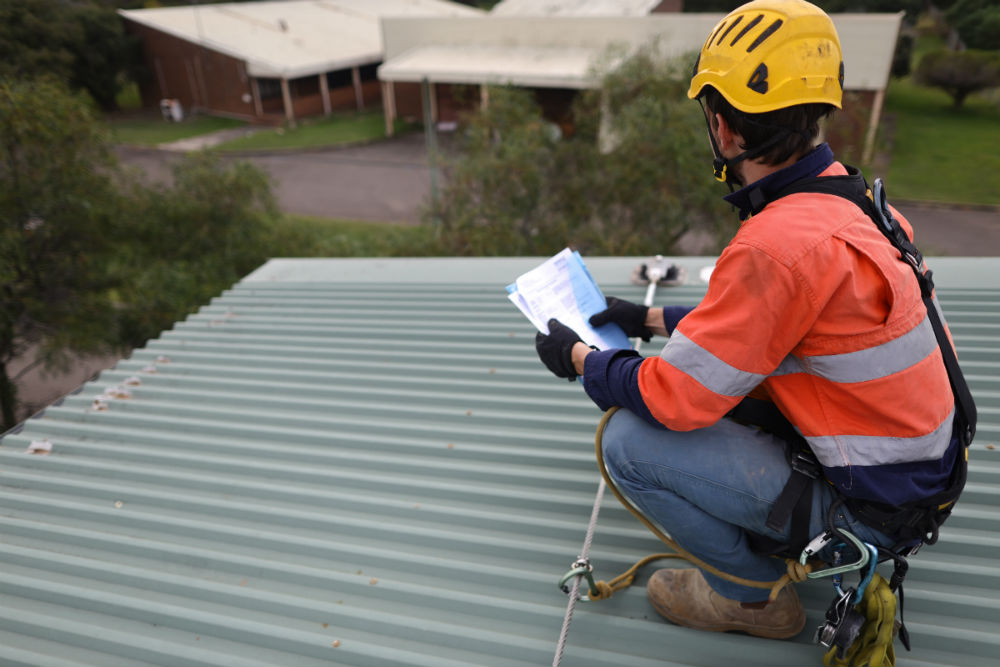To ensure worker safety and to help protect building and business owners from liability, the Occupational Safety and Health Administration (a part of the US Department of Labor) has numerous standards and restrictions that must be adhered to.
At A-to-Z Roofing & Exteriors, we know how important it is to maintain rigorous adherence to safety protocols. Roofing is inherently dangerous work, and to keep our employees safe, we take every step necessary to safeguard them from injury on the job. This includes educating them as well as our customers about the manifold rules and regulations instituted by OSHA.
In this article, we’re going to be explaining OSHAs stance on low-slope roofs. Typically, a low-slope roof is used on larger, commercial buildings. Residential structures normally make use of more traditional roofing styles like Dormer, Gable, or Saltbox.
Knowing how OSHA defines a low-slope roof helps roofers to know what steps to take to adequately protect themselves before, during, and after work begins.
Low-Slope and ‘Flat’ Roof Slopes
In architecture, the term ‘slope’ refers to the angle a roof has, and it’s typically measured in inches over a 12-inch span. For example, a typical Gable-style residential roof might have a 4/12 slope (also referred to as ‘pitch’). This means that the roof rises 4” every foot from the overhang to the ridge board (located at the apex of the roof).
Often, the 4/12 descriptor will be simplified to ⅓; they both effectively refer to the same slope or pitch measurement. The term ‘flat’ roof really is a misnomer, as few roofs are perfectly flat. If they were, they wouldn’t effectively drain water, and standing water on a roof can cause serious damage over time. Still, many people in the roofing industry use the term ‘flat roof’ to describe any roof that appears flat, even though it most likely has a slight slope to it.
How OSHA Defines Low-Slope
According to OSHA, a low-slope roof is any roof that has less than a 4/12 slope.

For roofs with this kind of geometry, there are very specific safety guidelines spelled out in OSHAs regulations. They include:
- Warning-line systems. OSHA requires that a warning line be installed along the perimeter of any low-slope or flat roof at least 6 feet from the edge of the roof. This warning line system can’t be relied on by itself, as there will invariably be work that must be done in the zone between the warning line and the edge of the roof. For roofs that are less than 50 feet in width, warning lines are not required.
When work near the edge of a low-slope roof needs to be completed, at least one additional safety precaution must be in place. - Dedicated safety monitors. OSHA regulations dictate that whenever a warning line system or other safety monitoring system is in place, employers must assign a person whose sole responsibility is monitoring for safety. These individuals must be competent in the recognition of fall hazards, capable of issuing warnings to all workers in the area, and close enough to all workers that they can properly observe their activities throughout the roof repair or replacement process.
- Guardrail systems. Before work can begin on many low-slope roofs, a guardrail system is often installed. This guardrail must meet OSHAs specifications for height and composition. These guardrail systems can either be temporary or permanent, though they are more often temporary and are removed after roofing work has been completed.
- Safety net systems. In especially high or hazardous environments, a safety net can be required by OSHA regulations to be installed during roofing activities. These safety net systems have requirements of their own, and they’re intended to not only protect the roofers from falls, but to also protect the persons and property below the roof from falling debris.
- Personal Fall Arrest (PFA) systems. A Personal Fall Arrest system normally consists of a body harness that is securely attached to a tether anchored to the building. The harness and tether (also called a lanyard) must meet OSHA industry standards and must be inspected for wear before every use.
Safety First at A-to-Z Roofing & Exteriors
Since 1993, A-to-Z Roofing & Exteriors has maintained strict adherence to rigorous safety protocols because we want to keep our employees free from harm as they work.
Whether you need roofing work on a low-slope, ‘flat’, or traditional residential roof, we have the knowledge and experience necessary to get the job done quickly and effectively.
To learn more, contact our team today.

